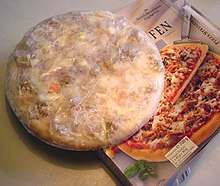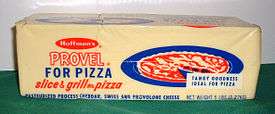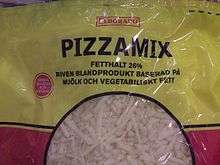Pizza cheese
Pizza cheese encompasses several varieties and types of cheeses and dairy products that are designed and manufactured for use specifically on pizza. These include processed and modified cheese such as mozzarella-like processed cheeses and mozzarella variants. The term can also refer to any type of cheese suitable for use on pizza.[1] The most popular cheeses used in the preparation of pizza are mozzarella (accounting for about 30%), provolone, cheddar and Parmesan. Emmental, Romano and ricotta are often used as toppings, and processed pizza cheeses manufactured specifically for pizza are mass-produced.[2] Some mass-produced pizza cheeses are frozen after manufacturing and shipped frozen.
| Part of a series on |
| Pizza |
|---|
.jpg) |
|
Pizza varieties
|
|
Cooking variations
|
|
Pizza tools
|
Processed pizza cheese is manufactured to produce optimal qualities in browning, melting, stretchiness and fat and moisture content. Several studies and experiments have analyzed the impact of vegetable oil, manufacturing and culture processes,[3] denatured whey proteins[4][5] and other changes to create ideal and economical pizza cheeses.[6] In 1997, it was estimated that annual production of pizza cheese products was 2 billion pounds in the United States and 200 million pounds in Europe, and in 2000 demand for the product in Europe was increasing by 8% per year. The trend of steadily-increasing production and consumption of mozzarella and pizza cheese continued into the first decade of the 21st century in the United States.[7]
Varieties and types

The International Dictionary of Food and Cooking defines pizza cheese as "a soft spun-curd cheese similar to Mozzarella made from cow's milk..." that is "...used particularly for pizzas and contains somewhat less water than real Mozzarella..."[8] Most are at least 95 percent Mozzarella,[9] with different moisture and fat densities.[1][10] Cheese for frozen pizzas may be comminuted, in which the cheese is processed into minute granules or fragments.[11] Low-moisture Mozzarella can be formulated specifically for pizza.[12][13] Cheese may be processed into blocks, from which the product can be grated, made into granules or sliced for use on pizza[14][15] or other foods. Pizza cheese frequently consists of a blend of two or more cheeses, such as low-moisture Mozzarella or Provolone.[1] Low-moisture Mozzarella was first manufactured in dairy factories in the Midwestern United States, and was originally called "pizza cheese".[16] Compared to standard Mozzarella, low-moisture Mozzarella has a firmer texture, is easier to grate, has better browning and melting characteristics, and is less perishable.[16]
Globally, Mozzarella is the most popular pizza cheese.[17] However, it has been estimated that in the United States only 30% of all pizza cheese used is actual Mozzarella.[18] Provolone is the second most popular one.[1] Cheddar may be mixed with Mozzarella to preserve chewiness.[1] Grated Parmesan may be added to the top of a pizza, and typically does not melt well when cooked.[1] A diverse variety of processed pizza cheeses are produced, including analogue cheese. Provel is one example. Other pizza cheeses include Emmental, Romano[19] and Ricotta for calzones or as a topping.[20][21]
Several cheeses may be mixed together in its formulation, and each has individual browning and blistering characteristics.[17] For example, a combination of Mozzarella and Cheddar may blister less when cooked compared to other combinations, because cheddar has less elasticity, while Mozzarella and provolone may brown less compared to other combinations.[17]
Processed pizza cheeses


Pasteurized and processed cheese-like products for pizza that are quicker and cheaper to produce than real cheese[22] and designed to melt well and remain chewy are used on many mass-produced pizzas in North America and the United Kingdom.[23][24] These products are referred to as analogue (or analog) pizza cheese;[25] in the UK the term "cheese analogue" is used, making clear that it is not actually cheese. In the book Technology of Cheesemaking, editors Law and Tamimethat state that analogue pizza cheese appears to be the leading type of cheese analogue produced globally.[26] Each year in the United States, 700 million frozen pizzas are sold, three-quarters of which contain cheese substitutes.[27]
Analogue pizza cheeses may be formulated for processing with less sophisticated cheese-making equipment than is required for Mozzarella cheese, such as using simple mixing and molding.[28] They tend to have a soft texture and once melted, may have a slightly "stringy" quality when pulled or bitten into. They may lack in a fusion, or melting together of the shredded product when cooked, in which the cheese gels together.[26] New stabilizer systems have been developed that have helped to enable the creation of analogue pizza cheeses.[29]
An example of a processed pizza cheese is Provel, which uses Cheddar, Swiss, and Provolone cheeses as flavorants.[30] Some analogue types are made with casein, a by-product of milk, and vegetable oil, rather than milk fat.[31] Casein-based Mozzarella-like imitation processed cheeses prepared using rennet are also used as a Mozzarella substitute on frozen pizzas.[26]
In some instances, the production of analogue pizza cheese can be similar to the production of cream cheese, although production may be different and homogenization may be avoided.[31] In some varieties, the product is heated to remain at a specific temperature and for a specific amount of time, which causes the proteins in the mix to gelatinize.[31] During this process, salts in the mix serve to emulsify it and thus improve the meltability of the final product.[31] The heated product is then placed in packaging such as bags-in-boxes while still hot, as it is more easily handled in this state compared to when in a solid state.[31] During packaging, these types of pizza cheeses are then quick-cooled to avoid browning of the product, which can occur via the Maillard reaction.[31]
Research and development

Manufacturers and academics have conducted studies and experiments in an effort to improve the stretchiness, melting characteristics, browning, fat content and water retention of pizza cheese.[32] Several patents exist for specialized varieties of pizza cheese and for its processing.[33][34][35] A study by Rudan and Barbano found that the addition of a thin layer of vegetable oil atop low- and reduced-fat pizza cheese increased meltability and reduced browning and dehydration when the product was cooked, but the texture remained overly chewy and tough.[26] A study by Perry et al. found various methods to heighten the melt of low-fat pizza cheese by increasing its moisture, including the use of pre-acidification, fat-replacers, and exopolysaccharide starter cultures as well as higher pasteurization temperatures.[26]
Manufacturers aim for a moisture content of 50-to-52 percent and a fat-in-dry-matter content of 35-to-40 percent.[4] A study published in the International Journal of Food & Science Technology found that a 12.5:87.5 blend of vetch milk and bovine milk improved stretchiness and melting characteristics.[36] Vetch is a legume that has seeds which are similar to lentils.[37] An experiment published in the International Journal of Dairy Technology suggested that the level of galactose, a monosaccharide sugar that is less sweet than glucose and fructose, can be reduced using different culture techniques.[38] An article in the International Journal of Food Engineering found that trisodium citrate, a food additive used to preserve and add flavor to foods, slightly improved the preferred qualities of pizza cheese.[39] Research published in Dairy Industries International suggested that denatured whey proteins increased moisture retention, but that the improvements were very slight and not economically worthwhile relative to the minor improvements.[4]
Some consumers prefer pizza cheese with less browning, which can be achieved using low-moisture part-skim Mozzarella with a low galactose content.[38][nb 1] Some varieties derived from skim mozzarella variants were designed not to require aging or the use of fermentation starter.[10] Others can be produced through the direct acidification of milk, which may be used in place of bacterial fermentation.[10][40]
Production and business
In the United States, the production and consumption of Mozzarella and pizza cheese steadily increased in the mid-20th century, and this trend has continued into the first decade of the 21st century.[7] In the U.S., several hundred million pounds of pizza cheese is consumed annually.[18] In 1997, it was estimated that annual production of the product was 1 million tons (2 billion pounds) in the United States and 100,000 tonnes (98,000 long tons; 110,000 short tons, 220,460,000 pounds) in Europe.[41] It has been estimated that 30% of all pizza cheese used in the United States is Mozzarella cheese.[18] As of 2000, demand for the product was growing in Europe by 8 percent per year.[9]
Mass-produced pizza cheese is used by the foodservice industry, quick service restaurants,[2] and other industries and businesses. The world's largest manufacturer of pizza cheese, Leprino Foods Company, processes 600,000 tonnes (590,000 long tons; 660,000 short tons, 1,322,760,000 pounds) a year.[9] Leprino Foods holds patents for some specialized Mozzarella production processes that enable the quick manufacture of the product.[42] One such product is a frozen shredded cheese used for pizza that is created in a few hours from milk.[43] Other U.S. companies also mass-produce pizza cheese, which is shipped in a frozen state.[44][45] As of 2000, Glanbia is the largest producer of pizza cheese in Europe.[46] Some retail and commercially mass-produced frozen pizzas have cheese stuffed into the pizza crust.[47][48][49]
Use by region
Significant amounts of pizza cheese are used in Europe,[41][46] Australia, New Zealand[41] and the United States. Whole milk mozzarella is popular in pizzas in the East and Southwest regions of the U.S., while one survey showed that Provolone was more popular on the east and west coast.[1] Cheddar may be used more in the Eastern and Southern regions of the U.S.[1] Provel cheese is typically used in the preparation of St. Louis-style pizza in the U.S.[50]
See also
- Food processing
- Novozymes
- List of cheeses
- Pasta filata – a technique to produce a stretched curd cheese suitable for pizza.
- Pizza in the United States
Notes
- Galactose is a type of sugar found in dairy products and other foods that is less sweet than glucose. Sugar in foods can lead to caramelization when they are cooked, which increases their browning.
References
- Correll, John. "Chapter 9 – Pizza Cheese". Archived from the original on July 25, 2011. Retrieved October 13, 2012.
- Burke-Kennedy, Eoin (September 4, 2014). "Irish Dairy Board Buys Spanish Pizza Cheese Maker Luxtor". The Irish Times. Archived from the original on February 20, 2016. Retrieved February 12, 2016 – via Highbeam.
- "DuPont Nutrition & Health Hurdles the Process Challenges for Pizza Cheese". Danisco.com (Press release). DuPont Nutrition & Health. April 3, 2012. Retrieved October 16, 2012.
- "Whey proteins and pizza cheese". Vol. 66 Issue 9. Dairy Industries International. September 2001. p. 16. Retrieved September 28, 2012.
- "Effect of incorporation of denatured whey proteins on chemical composition and functionality of pizza cheese". Australian Journal of Dairy Technology. 2001. ISSN 0004-9433. Retrieved September 27, 2012.
- Guinee, Timothy P. (May 2000). "The compositional and functional properties of commercial mozzarella, cheddar and analogue pizza cheeses". International Journal of Dairy Technology. 53 (2): 51–56. doi:10.1111/j.1471-0307.2000.tb02658.x.
- Kindstedt, P. (2012). Cheese and Culture: A History of Cheese and its Place in Western Civilization. Chelsea Green Publishing. p. 210. ISBN 978-1-60358-412-8.
- Sinclair, Charles G. (1998). International Dictionary of Food and Cooking. Fitzroy Dearborn Publishers. p. 417. ISBN 978-1579580575. Retrieved September 28, 2012.
- "Firms unite to drive pizza cheese sales". Vol. 65 no. 9. Dairy Industries International. September 1, 2000. p. 7. Archived from the original on March 6, 2014 – via Highbeam. Cite magazine requires
|magazine=(help) - McMahon; et al. (September 5, 2000). "Manufacture of Lower-fat and Fat-free Pizza Cheese". United States Patent and Trademark Office. Retrieved September 28, 2012.
- Kielsmeier, Lester O.; Barz, Richard L.; Allen, Wesley J. (June 29, 1988). "Pizza Preparation from Comminuted Cheese". United States Patent and Trademark Office. Retrieved September 28, 2012.
- Aikenhead, Charles (June 1, 2003). "Permanently pizza: continuous production of pizza cheese is now a realistic proposition". Dairy Industries International. Archived from the original on January 25, 2013. Retrieved September 30, 2012 – via Highbeam.
- Fox, Patrick F. (1999). Cheese: Chemistry, Physics and Microbiology (Major Cheese Groups). 2. Aspen Publishers. ISBN 978-0412535109. Retrieved September 27, 2012.
- Kielsmeier, Lester O.; Barz, Richard L.; Allen, Wesley J. (March 5, 1991). "Method of baking pizza from coated frozen cheese granules". United States Patent 4997670. Freepatentsonline.com. Retrieved October 16, 2012.
- "Machine for Shredding Cheese and for Depositing the Cheese Onto Pizzas". United States Patent 3662677. Freepatentsonline.com. May 16, 1972. Retrieved October 16, 2012.
- "Pizza cheese? It's a drier mozzarella". Chicago Sun-Times. April 29, 1998. Archived from the original on February 20, 2016. Retrieved February 12, 2016 – via Highbeam.
- Howard, Jacqueline (August 24, 2014). "YUM! Scientists Reveal Key To Making The Perfect Pizza". The Huffington Post. Retrieved February 12, 2016.
- "Pizza's Global Footprint". Forbes. February 20, 2007. Retrieved September 28, 2012.
- Bittman, M. (2010). Mark Bittman's Quick and Easy Recipes from the New York Times. Potter/TenSpeed/Harmony. p. 258. ISBN 978-0-307-88548-7.
- Fraioli, J.O. (2009). Pizza & Wine: Authentic Italian Recipes and Wine Pairings. Gibbs Smith, Publisher. p. 138. ISBN 978-1-4236-1250-6.
- Adler, K.; Fertig, J. (2014). Patio Pizzeria: Artisan Pizza and Flatbreads on the Grill. Running Press. p. 210. ISBN 978-0-7624-4966-8.
- "BBC One - Food Factory, Ready-Made, Fake cheese". BBC. July 18, 2012. Retrieved May 7, 2017.
- Gates, Stefan (July 18, 2012). "Fake cheese (text and video)". BBC. Retrieved October 17, 2012.
- Hayes, David K.; Miller, Allisha (2011). Revenue Management for the Hospitality Industry. John Wiley & Sons, Inc. p. 60. ISBN 9780470393086. Retrieved September 29, 2012.
- Advanced Dairy Chemistry – P. F. Fox, P. L. H. McSweeney – Google Books
- Law, Barry A (2010). Tamime, A.Y. (ed.). Technology of Cheesemaking. Wiley-Blackwell. ISBN 9781444323757.
- "Star Tribune Archives". Nl.newsbank.com. September 11, 1987. Retrieved September 28, 2012.
About three-fourths of the 700 million frozen pizzas sold each year in the United States contain cheese substitutes. The most common is casein,...
- Gunasekaran, Sundaram; Mehmet Ak, M. (2003). Cheese Rheology and Texture. CRC Press. p. 288. ISBN 978-1587160219. Retrieved September 30, 2012.
- Kuhl, Rudiger (October 1, 2003). "Stabiliser systems—the key to a great pizza: when it comes to judging the taste and quality of pizza it depends on one critical ingredient—pizza cheese". International Food Ingredients. Archived from the original on March 6, 2014. Retrieved October 16, 2012 – via Highbeam.
- Hulin, Belinda (2007). The Everything Pizza Cookbook: 300 Crowd-Pleasing Slices of Heaven. F+W Publications, Inc. p. 7. ISBN 978-1598692594. Retrieved September 30, 2012.
- "Continuous Production of Analogue Cheese" (PDF). Danish Dairy & Food Industry Worldwide. 2007. pp. 12–13. Retrieved October 17, 2012.
- Kindstedt, P.S. "Recent developments in the science and technology of pizza cheese". Australian Journal of Dairy Technology. Retrieved September 27, 2012.
- Reinbold; et al. (April 18, 1978). "Preparation of Pizza Cheese". United States Patent and Trademark Office. Retrieved September 27, 2012.
- "Manufacture of lower-fat and fat-free pizza cheese (Patent #6113953)". Google Patents. Retrieved October 11, 2012.
- "Pizza cheese (Patent # EP0920259A1)". Google Patents. Retrieved October 11, 2012.
- Piggott, John R.; Ahmad, Muhammad Mushtaq; Hussain, Sarfraz; Ahmad, Nasir; Owusu-Darko, Patricia (September 11, 2007), "Preparation and evaluation of pizza cheese made from blend of vetch–bovine milk", International Journal of Food Science, 43 (5): 770–778, doi:10.1111/j.1365-2621.2006.01512.x
- Halliday, Jess (September 14, 2007). "Vetch blend shows sromise as low-fat pizza topping". William Reed Business Media. Retrieved February 16, 2016.
- Baskaran, D.; Sivakumar, S. (November 2003). "Galactose concentration in pizza cheese prepared by three different culture techniques". International Journal of Dairy Technology. 56 (4): 229–232. doi:10.1046/j.1471-0307.2003.00109.x.
- Farahmandfar, Reza; Mazaheri Tehrani, Mostafa; Razavi, Seyed Mohammad Ali; Habibi Najafi, Mohammad Bagher (2010). "Effect of Soy Cheese and Trisodium Citrate on Pizza Cheese". International Journal of Food Engineering. 6 (5). doi:10.2202/1556-3758.1777.
- Breene, W.M.; Price, W.V.; Ernstrom, C.A. (November 1964). "Manufacture of Pizza Cheese without Starter". Journal of Dairy Science. 47 (11): 1173–1180. doi:10.3168/jds.s0022-0302(64)88877-9.
- Fox, Patrick F.; et al. (2000). Fundamentals of Cheese Science. Aspen Pub. p. 482. ISBN 978-0834212602.
- (Staff) (June 20, 2012). "Leprino Foods a big market for Morgan County dairies". Fort Morgan Times. Retrieved October 16, 2012.
- Wirthman, Lisa (March 30, 2012). "Denver's Leprino Foods has strong hold on cheese market". Denver Business Journal. Retrieved October 16, 2012.
- Mielke, Lee (February 2, 2016). "Not a good Groundhog Day for dairy". Capital Press. Retrieved February 12, 2016.
- Schuman, Sydney (September 4, 2013). "Men arrested with $421,700 of marijuana hidden in pizza cheese". The Arizona Republic. Retrieved February 12, 2016.
- World Retail Directory and Sourcebook 1999–2000. Euromonitor. 2000. p. 193. ISBN 978-0-86338-882-8.
- Kirkova, Deni (February 3, 2016). "Get stuffed crust pizza at Europe's first all-vegan Italian restaurant". Metro. Retrieved February 12, 2016.
- Strutner, Suzy (January 27, 2016). "Pizza Hut's New Creation Looks Too Gooey-Good To Be True". The Huffington Post. Retrieved February 12, 2016.
- "Ornua develops new 'low-melt' cheese ropes for pizza crusts". Food & Beverage International. February 4, 2016. Retrieved February 12, 2016.
- Bonwich, Joe (April 11, 2007). "Family ties pave the way to provel's enduring popularity". St Louis Post-Dispatch. Archived from the original on June 25, 2011. Retrieved February 12, 2016 – via Highbeam.
Further reading
- Law, Barry A (2010). Tamime, A.Y. (ed.). Technology of Cheesemaking. Wiley-Blackwell. pp. 13–14, 21, 198, 348, 358–381, 383–385, 387, 508. ISBN 9781444323757. Archived from the original on June 2, 2012. Retrieved October 17, 2012.
- Sherkat, F.; Walker, M. "Functionality and consumer acceptance of pizza cheese analogue". Vol 57, no 2. Dairy Industry Association of Australia. Retrieved October 17, 2012.
- Govindasamy-Lucey, S.; et al. (February 2006). "Influence of Condensed Sweet Cream Buttermilk on the Manufacture, Yield, and Functionality of Pizza Cheese". Journal of Dairy Science. 89 (2): 454–467. doi:10.3168/jds.s0022-0302(06)72109-9. PMID 16428615.
- "Chr Hansen and Novozymes develop enzyme for producing pizza cheese from whey". Chemical Business Newsbase. March 9, 2009. Retrieved September 28, 2012.
- Kindstedt, P. S.; et al. (1997). "Chemically-acidified pizza cheese production and functionality". Irish Republic, Dairy Products Research Centre [5th Cheese Symposium]; Irish Republic, Univ. of Cork. Retrieved September 27, 2012.
- "Better Pizza Cheese Processing". Prepared Foods. May 1, 2012. Archived from the original on February 20, 2016. Retrieved February 12, 2016 – via Highbeam.
- "G.C. Hahn & Co.: Supplier Spotlight". Dairy Foods. January 1, 2006. Archived from the original on May 10, 2013. Retrieved September 30, 2012 – via Highbeam.
- Gunstone, F.D.; et al. (2006). Modifying lipids for use in food. Woodhead. p. 476. ISBN 978-1855739710. Retrieved September 30, 2012.
External links
